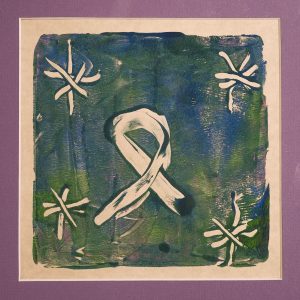I provide art therapy psychosocial support to patients being treated for hematology (blood-related) and oncology (cancer) diagnoses at Siteman Kids at St. Louis Children’s Hospital. I commonly get asked what art therapy is, how I became a children’s art therapist, and how it helps a patient during cancer treatment. My goal is to provide a healing space for these kids and an opportunity to explore thoughts, feelings, and experiences related to treatment through active art engagement. Ultimately, I want to empower each child to embrace the importance of play and creativity. This will support positive coping during their treatment process.
How do you become an Art Therapist?
To become a children’s art therapist, I needed to:
- Graduate from an accredited Art Therapy Graduate Program (coursework with a direct focus on the use of art making within the context of mental health counseling)
- Complete 1,000+ hours of clinical supervised experience between my time in school and once I graduated
- Complete necessary exams to fulfill the requirements for credentialing when persuing my additional Licensed Professional Counselor identification.
What is Art Therapy?
When broken down into its simplest form, art therapy is mental health counseling and art making, beautifully blended together. Not much unlike traditional forms of talk therapy in which you are mainly using your voice as your tool for communicating your thoughts, feelings, and experiences; in art therapy, we use engagement with art materials as our tool within the therapeutic relationship to communicate and process what one may be going through and opting for the use of art as our tool speaks directly to a child’s basic need to learn through the act of play and active engagement with their surroundings. In doing so, we provide a space where a child can gain mastery and understanding within their environment. We also provide a vehicle of communication for concepts that may be difficult to articulate verbally.
What does Pediatric Hematology/Oncology Art Therapy look like at St. Louis Children’s Hospital?
I see patients three years old and older. Often, I hear, “Timmy would be great for art therapy. He loves to color,” to which I always say, “Yes, and“. Yes, it is wonderful that a patient already has a passion for art engagement, and it is not a prerequisite to benefit from art therapy.
Within an art therapy session, background knowledge of art making or creating an aesthetically pleasing outcome is not needed. The true impact of art therapy is ultimately not about the product but more about the process of making art. Within that, art making can take many forms throughout the art therapy process. From simply drawing how you are feeling, learning a new skill/technique to gain mastery, manipulating clay within your hands to practice grounding within the present moment, or engaging materials in a way that supports interpersonal communication between patient/family and/or hospital staff; all can be key opportunities to practice vital skills necessary for resiliency throughout treatment.
What are the Reasons for Referring a patient to Art Therapy during Cancer Treatment?
Going through treatment can bring about a lot that is largely unknown and perhaps at times quite scary. Many times, as a pediatric hematology/oncology art therapist, I am referred to patients and families shortly following an initial diagnosis of cancer or admission for hematological treatment (such as a pain crisis for individuals with sickle cell disease). I then continue to provide follow up care throughout their treatment course at St. Louis Children’s Hospital.
As a children’s art therapist, I am here as a constant, supportive, and compassionate team member to help with the following common needs:
- Support of initial adjustment to the hospitalization process
- Develop key coping skills necessary for ongoing treatment needs
- Engagement of essential developmentally appropriate creativity/play to promote feelings of joy and simply being a kid
- Support the overall reduction of pain symptoms through intentional forms of distraction or sensory relaxation.
What is the Ultimate Goal of Art Therapy?
The ultimate goal of all art therapy at St. Louis Children’s Hospital is to provide a patient with an opportunity to be seen, heard, and understood with a strong emphasis on promoting chances for a kid to be a kid. Within that, we as art therapists do not own the art supplies. We highly encourage patients and their families to engage with creating outside of therapy sessions. In doing so, we are normalizing play/creativity and a foundation for practicing self-care and positive coping skills.







Comments